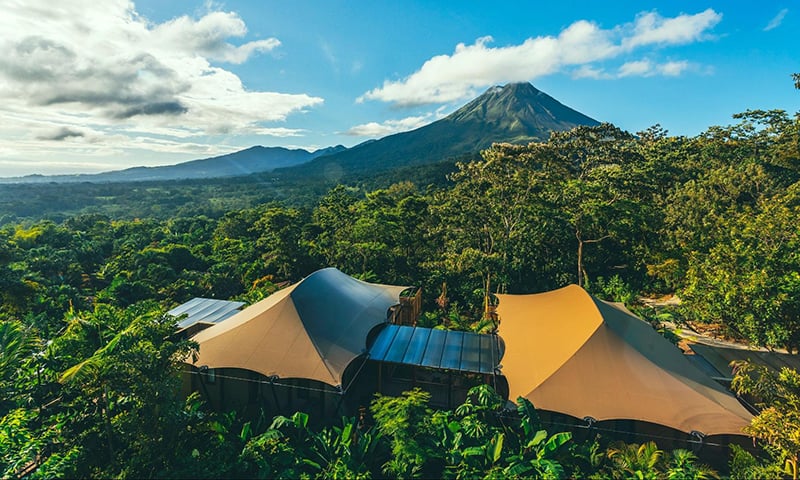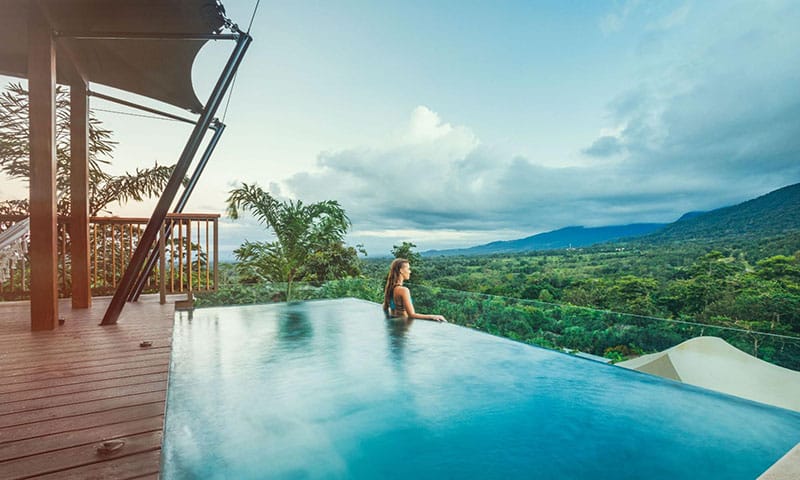.jpg?width=1600&name=Earth%20in%20Focus%20%20A%20Journey%20Through%20Our%20Changing%20Landscapes%20(3).jpg)
Earth in Focus | A Journey Through Our Changing Landscapes
Have you ever wandered through a deep forest, gazed across a rugged coast, or marveled at a breathtaking mountainside, and wondered how such a stunning landscape came to be?
It's not a question that crosses everyone's mind, and that's perfectly okay. Nature's beauty is a treasure in itself, offering endless moments of gratitude, wonder, and appreciation.
At Nayara Resorts, we experience this magic daily. Whether venturing into the Arenal Rainforest, exploring the Atacama Desert, trekking around Easter Island, or sailing through Bocas del Toro, the awe these landscapes inspire never fades.
Yet, each landscape—whether within the bounds of our resorts or beyond—holds a story waiting to be uncovered. Every rugged coast, archipelago, towering volcano, and arid desert is the result of millions of years of Earth’s history. Each has a tale as unique as the landscape itself.
Today, we invite you to explore the histories of the four landscapes we call home at Nayara Resorts. Discover the tectonic shifts, mass migrations, and climate evolutions that shaped them. We hope these stories inspire you to delve into the geological history of your own surroundings and the places you explore!
The Arenal Volcano and The Costa Rican Rainforest
.jpg?width=1112&height=667&name=Earth%20in%20Focus%20%20A%20Journey%20Through%20Our%20Changing%20Landscapes%20(2).jpg)
The story of Costa Rica, as we know it, began around 3 million years ago with the rise of the Isthmus of Panama. This narrow land bridge, stretching from Costa Rica’s eastern border to Colombia’s western edge, emerged from the ocean, connecting North and South America and separating the Atlantic and Pacific Oceans.
For marine life, this separation marked a pivotal evolutionary moment, creating distinct paths for species in the newly formed Caribbean and Pacific waters. On land, the Great American Biotic Interchange began with species from both continents migrating, mingling, and diversifying across the connected landmasses.
.png?width=272&height=331&name=Earth%20in%20Focus%20%20A%20Journey%20Through%20Our%20Changing%20Landscapes%20(1).png)
Costa Rica, situated at the heart of these monumental geological shifts, became a cradle for the emergence of new species. However, the country’s extraordinary biodiversity owes just as much to another factor: the presence of the Arenal Volcano and the numerous other volcanoes dotting the landscape.
Located on the Pacific Ring of Fire, Costa Rica sits atop one of the most volcanically active regions on Earth. Over millions of years, volcanic eruptions sculpted the rugged, mountainous terrain that defines much of the country. This dynamic landscape gave rise to twelve distinct microclimates and thousands of unique habitats, each teeming with life.
The result is a simple yet profound recipe for diversity: two continents' worth of species converging on a mosaic of habitats shaped by volcanic activity and evolving climatic patterns, with over 3 million years to adapt, compete, and thrive. The fruits of this ancient process are on full display every time you step outside your room at Nayara Tented Camp, Nayara Springs, or Nayara Gardens.
The Bocas del Toro Archipelago
.jpg?width=1387&height=832&name=Earth%20in%20Focus%20%20A%20Journey%20Through%20Our%20Changing%20Landscapes%20(1).jpg)
The story of the Bocas del Toro archipelago shares a deep connection with Costa Rica's ancient history, thanks to its position on the Isthmus of Panama. Like Costa Rica, Bocas del Toro benefited from the Great American Biotic Interchange and the rugged landscapes that have fostered such remarkable biodiversity.
However, the most defining moments in Bocas del Toro’s geological history occurred relatively recently on a geological timescale. Just 8,000 years ago—an instant in the grand timeline of tectonic shifts and biological evolution—rising sea levels isolated the islands of Bocas del Toro from the mainland. What was once a region of rugged coastal peaks transformed into the half-submerged landscape we see today.
As always, wildlife adapted. Aquatic species quickly claimed the new shallow water habitats, competing for dominance. Terrestrial life, either isolated on the islands and evolving into unique species or adapting to the new environment, learned to thrive. Examples include the endemic mangrove oysters, snails, and crabs that have made these islands their home.
Today, 8,000 years later, this captivating ecosystem of sunken mountains continues to evolve, shaped by the ocean's influence, species migrations from the mainland, and the ongoing adaptations of its unique inhabitants. And here, we've only begun to explore its wonders. Dive in with us at Nayara Bocas del Toro to uncover more of this fascinating story.
Easter Island
.jpg?width=1290&height=774&name=Earth%20in%20Focus%20%20A%20Journey%20Through%20Our%20Changing%20Landscapes%20(6).jpg)
Here’s a fun question: What do Panama and Costa Rica have in common with Easter Island, an isolated landmass over 5,000 kilometers (3,000 miles) away? All three were shaped by volcanic activity! However, while Panama and Costa Rica are part of larger landmasses, Easter Island stands alone, more than 1,800 kilometers from the nearest inhabited island and over 3,500 kilometers from mainland Chile.
Easter Island is actually the peak of three massive undersea volcanoes that gradually merged over millions of years. It's believed that Easter Island broke through the ocean's surface around 700,000 years ago, making it relatively young as far as islands go.
Yet, 700,000 years is ample time for nature to adapt. Seeds carried by migratory birds, as well as wind and ocean currents, began to populate the island’s landscape. Meanwhile, amphibious species that inhabited the submerged volcanoes before they emerged evolved into Easter Island’s endemic animal species.
However, unlike the inspiring tale of adaptation seen in Bocas del Toro, Easter Island’s ecological history carries a cautionary twist. The arrival of Polynesian settlers—and later European settlers—brought new plant and animal species that competed fiercely with the island’s native life. Human activities such as farming and animal husbandry further disrupted the fragile ecosystem.
Today, it's believed that many of the species once unique to Easter Island have vanished forever. Yet, there is hope. Over 100 species of plants, animals, and fish that are found nowhere else on Earth still survive on Easter Island. This fragile ecosystem has been preserved, and there is potential for it to flourish with diversity once again.
The Atacama Desert
.jpg?width=1323&height=794&name=Earth%20in%20Focus%20%20A%20Journey%20Through%20Our%20Changing%20Landscapes%20(5).jpg)
Compared to the lush rainforests of Arenal and Bocas del Toro or the rich coastal waters around Easter Island, the canyons, plains, and valleys of the Atacama Desert might seem barren at first glance.
However, the Atacama Desert is one of the most unique habitats on Earth—so otherworldly that it's been used as a training ground for astronauts and a testing site for unmanned rovers. Despite its harsh conditions, life abounds here, having adapted over millennia to survive in this extreme environment.
Some researchers believe the Atacama Desert is the oldest desert on the planet, with evidence suggesting that it became arid due to Antarctic wind currents as far back as 200 million years ago when today’s continents were part of a supercontinent called Pangea.
In those ancient times, the Atacama was dry, but not the hyper-arid region it is today. Its climate was thought to resemble that of modern-day Namibia on Africa’s southwest coast. However, the rise of the central Andes, which occurred between 6 and 10 million years ago, dramatically altered the region’s climate through the rain shadow effect.
As a result, the Atacama transformed from a typical desert into one of the driest places on Earth. In fact, some parts of the desert haven’t seen rainfall in centuries.
During this period, the species that inhabited the pre-Andean Atacama were pushed to their limits. While some migrated to more hospitable environments, those that remained evolved extraordinary traits and adaptations to endure the extreme aridity.
Today, these resilient plants and animals thrive in a landscape where 99.9% of life on Earth would perish within a week. If you're curious to learn more about these remarkable creatures and experience their home firsthand, you can do so at Nayara Alto Atacama.
Fascinating Stories All Around Us
The four stories we’ve shared today focus on some of the most interesting and unique locations on Earth, but everywhere around us there are fascinating stories of natural history. What are the major factors — biological, geographical, and occasionally human — that created your home habitat?
We’d love to have you visit one of the Nayara destinations to come share!


.jpg)
